The following information on becoming a firearms expert comes from Section 36 of Shooting by J. Henry FitzGerald. Shooting is also available to purchase in print.
The first requirement is a knowledge of firearms and ammunition covering all the latest arms and cartridges and also the older models. Many old model arms now laying in some trunk or drawer will appear at the scene of a crime and a working knowledge of the arms is necessary. Whenever an unfamiliar revolver or pistol appears study it, take it apart, and make notes on the direction of twist, width of lands and grooves, peculiarities of breech block, construction of chamber, action, grips, frame, etc. It does not follow that an expert cannot correctly testify about an arm of a make that he has never seen before. The land and groove marks of a bullet fired from the unfamiliar model will compare with the land and groove marks on another bullet fired from the same revolver or pistol if the barrel is of a size that fits the bullets. I mention this fact because in my experience I have encountered many times a modern cartridge loaded with smokeless powder and with a bullet too small to fit some of the older model arms. In fact one old model revolver of .38 caliber with a barrel designed to shoot the black powder, hollow base bullet is so large that the modern bullet .38 S&W or Colt Special will drop through the barrel.
If a modern bullet is shot in this revolver it is almost impossible to identify it due to the bullet striking first on one side and then on the other on its journey through the barrel. I was on such a case a few years ago. We had the confession and the owner of the revolver admitted that was the revolver used in the shooting, also that he had fired the shot, but I could not identify the bullet for the above reason and therefore did not testify.
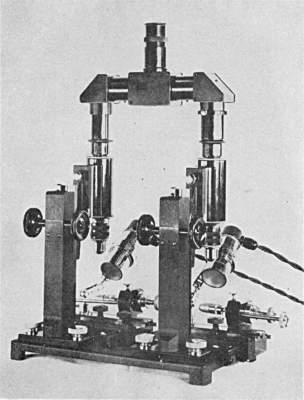
It makes no difference what proof is submitted through other sources the expert must by his own efforts build up his case. As the fatal bullet is received examine it for identification marks. In a recent case a bullet was submitted to me that had been carried by some one in the pocket or case for a period of time and all identification marks were erased. It was just a lump of lead and could not be identified. If our coroners and attorneys would use more care in the handling of bullets and shells our work would be easier. The proper way to preserve bullets and shells is to roll them in cotton, each one separately, and place cotton and exhibits in a serviceable box for future use.
Identification marks may be placed on bullets and shells for use in court if it is properly done without erasing marks in evidence. The bullets may be marked on base or rear end,—a straight line for number one bullet, two lines for number two bullet, and so on until each bullet has an individual mark. These marks should be registered in a notebook with the other material pertaining to the case and after each mark explain fully where bullet was found and everything relating to it,—date, hour, and minute it was found, names of those examining it, place it was kept from that time until the trial, and names of persons having access to it between those dates.
The shells, while not as easily damaged as the bullets, should be handled with the same care and marked at the open end either inside or out in a way that will not interfere with identification marks.
We are now back to the bullet. It may be first examined with a seven, eight, or ten power microscope, and in many cases this is powerful enough to discover prominent marks. If these are discovered the bullet is then placed in the comparison microscope with the prominent marks up or toward the glass. These marks may also be found by placing the bullet in the microscope without examination with a small glass.
With the revolver as received, fire a shot using the same make of ammunition and shape of bullet. This may be easily accomplished by purchasing a pound box of absorbent cotton; open the end of box, stand it up on the floor and fire a shot into the open end, being careful to fire the bullet straight into the cotton about halfway between center of cotton and edge of box; otherwise the entire roll of cotton must be opened and if the exact center of the cotton is hit the bullet may follow end of paper and cotton to the bottom of the roll. This package of cotton will stop revolver or automatic bullets, but will not stop rifle bullets. It is an added precaution to fire this shot in the basement, but it is not absolutely necessary. After the bullet is recovered it may be examined with small glass or put directly into the microscope with the prominent marks toward glass if they are found. Then adjust comparison eyepiece and the microscope to view one-half of each bullet. If the fatal bullet is badly defaced and parts of prominent identification marks are missing, then other marks may be used in comparison. Capt. William A. Jones was the owner of the first successful comparison microscope used in this work. A microscope of this kind is a very positive way of comparing bullets and shells.
The shell identification is similar to the bullet identification except that shells are stood on end and primers are compared, exposing one-half of each primer in microscope and comparing the markings on surface. Ejector and extractor marks on automatic shells are important and easily compared.
It is not necessary to go to the expense of purchasing a comparison microscope for ordinary cases, but it is the most accurate road to correct identification. Another addition which may be used in connection with comparison microscope is a camera, mounted on a standard without lens, that may be inverted and placed above microscope taking a picture of what you see. This picture may be enlarged to desired size and used in court work. I have used a binocular microscope, a monocular microscope, and several others for this work and while they will answer the purpose the comparison marks must be carried in the mind from one bullet to the other. Only in very low power glass can both bullets be seen at the same time. Finger prints and small objects may also be compared correctly with the comparison microscope. The proper lighting is very essential and the same power light used at each bullet.
The binocular microscope with horseshoe base is of great assistance in the examination of bullet holes, blood, powder stains, finger prints, and other material connected with a case, and in investigation work. It is an image-erecting scope and useful in many ways. The high-grade pocket magnifying glasses are very useful and easily carried.
The comparison of bullets and shells is very important and equally so is the effect of bullets on the human body, the body of an animal, wood, metal, glass and other substances. The contact shot is one which requires much study, for the effect of a contact shot is different in different parts of the body.
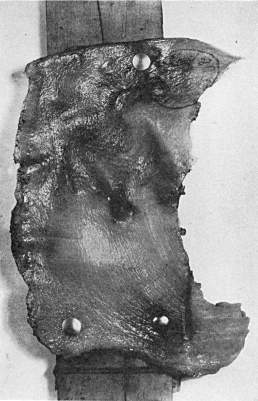
We will first analize the effect of a shot so fired with a cartridge loaded with smokeless powder. If the muzzle of the revolver or pistol is held tight against the side of the head as the shot is fired the effect will be a hole several sizes larger than the bullet, with the edges blackened and scorched and turned outward. A gas pocket about the size of a dollar will be formed around the bullet hole between flesh and bone in which will be found particles of powder and powder residue. As the bullet passes through the flesh and encounters the bone it is slowed up by the bone resistance and this hesitation of the bullet in its flight will tend to stop the onrushing gases, causing them to spread and form a gas pocket. A large per cent of the remaining gases will follow the bullet into the wound, sometimes tearing the tissue and causing a frightful wound inside the head. The outrushing blood will wash out some of the powder residue, particles of powder, and discoloration and will tend to cover the rest to the extent that a casual observation would create the idea that it was a clean wound. The revolver or pistol so fired may not have any bloodstains upon it because the onrushing gases following the bullet will check the flow of blood until the forward pressure of gas is released by the recoil of the revolver or pistol, which forces the muzzle away from the wound and upward. The hand holding the weapon would not be liable to show bloodstains for the same reason. The weapon may be found several feet away, if shot was fired when the person was standing up.
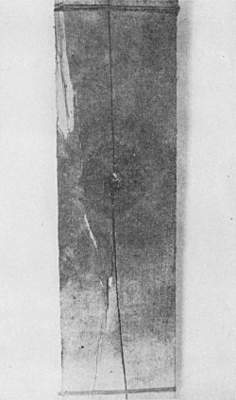
The effect of above shot fired from revolver and automatic pistols of different calibers and powers will differ as to size of wound, gas pocket, tearing of wound, etc., but the general characteristics will be the same. While smokeless powder is spoken of in this explanation of contact shots, there are different kinds of smokeless powder. Many revolver and all automatic cartridges are loaded with a flash powder, which is nearly all burned in the shell, while .32/20, .38/40, and .44/40 cartridges used in both rifle and revolver are usually loaded with a slower burning powder. This may be proved by laying a white paper on the ground or floor ten or twelve feet long and with revolver parallel with and six inches above the paper fire a shot. Unburned grains of powder will be found along the paper sometimes ten feet away. This will be especially true in the case of the .38/40 and .44/40 cartridges. The effect of gases from above-named cartridges on the wound described would be different from the description given and would give nearly the same results as black powder.
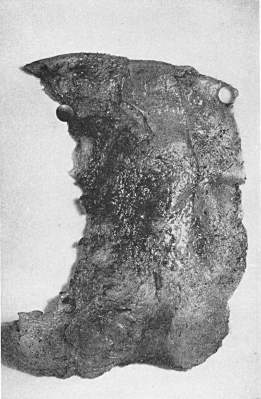
A contact shot when black powder is loaded in the cartridge will produce different results than that obtained with smokeless powder. The force of the gases is greater and the wound will be slightly larger, the edges more ragged or torn, the gas pocket larger, and a greater amount of powder and powder residue will be noted in pocket. The destruction of tissue will be greater in many cases, the flesh will be torn in several directions, from one-half to one and one-half inches in length.
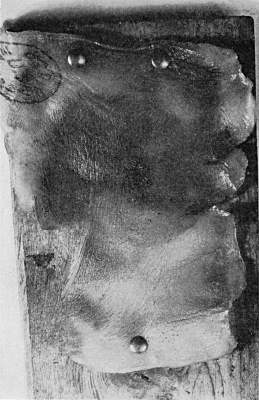
If the contact shot is fired with the weapon against the forehead the tearing of the flesh may be greater than when it is fired against the side of the head, due to the flesh being drawn tighter across forehead and curve of the bone. If the muzzle of the weapon is one-quarter of an inch away from the flesh and shot is fired no gas pocket will be found. The powder grains and residue will be found on the outside of the wound. As the distance increases the size of the circle containing powder grains and residue will increase and by using the same kind of cartridges, with powder in same condition, the distance at which a shot was fired can be estimated correctly to within one-half inch.
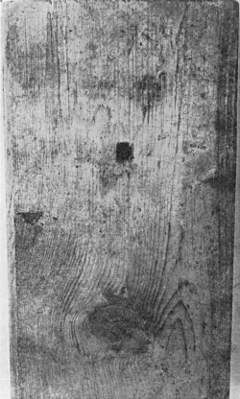
If a contact shot is fired with clothing, coat, vest or trousers between the muzzle of the gun and the body the gas pocket will in nearly all cases be absent, as gases escape through cloth leaving a ragged hole in the garment, but powder residue will be visible around the wound. Smokeless powder residue will be visible around the wound or on clothing at a distance of one-quarter inch to fifteen inches. The .32/20, .38/40, and .44/40 cartridges loaded with slow-burning smokeless powder will have powder residue visible if the shot is fired from one-quarter inch to twenty inches; black powder is visible from one-quarter inch to four feet, depending on the condition of the powder. If the cartridges have been kept in a damp place and the particles of powder have become caked or stuck together, this ball or mass of powder will go out of the barrel as a projectile and will cause powder stains up to the distance stated,—four feet.
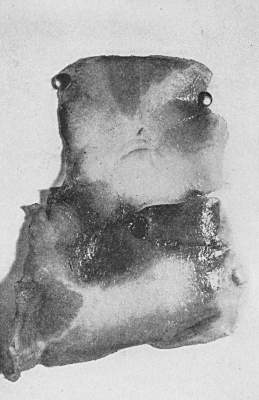
Formulas of different powders would not assist the expert because many powders are blended or made for special requirements and would have to be analyzed to determine the ingredients. The most successful results are accomplished by procuring ammunition of the same make, powder, and bullet; also date of manufacture, if possible, and perform experiments until the desired results are obtained.
A room in which a crime is committed by shooting should be thoroughly searched for bullet holes, powder stains, finger prints, etc., as every clue is important.
When appearing on a case, after viewing the exhibits go over the testimony with the attorney and give him a clear understanding of your deductions, also give him an outline of your qualifications in expert work on a card or paper that he can refer to when you are called to testify. The following are the qualifications which I use in court work:
Q. What is your name?
A. J. Henry FitzGerald.
Q. Where do you reside?
A. Hartford, Connecticut.
Q. What is your occupation?
A. The study of firearms, their construction and uses; the investigation of cases where firearms were used either to kill or to wound; police instructor; and giving expert testimony in trials where firearms were used.
Q. How many years have you experimented with firearms?
A. Thirty-nine years.
Q. How many experiments have you performed with firearms?
A. Over 150,000 experiments with different arms.
Q. Why were these experiments performed?
A. To gain the knowledge of firearms and their uses and also the knowledge of ammunition used in firearms.
Q. What is the nature of your testimony in regard to firearms?
A. The external effect of bullets on the human body and other substances, powder stains, scorches and burns on the human body and other substances. The direction of bullets, the comparison of land and groove marks in the different revolvers and pistols, the comparison of land and groove marks on bullets fired from the same and different revolvers and pistols, and the comparison of primers and shells fired in the same and different revolvers and pistols.
Q. Name some of the police departments you have instructed and are connected with.
A. I am shooting instructor of the New York State Police and a member of that organization; a member of the faculty and firearms inspector instructor in the New York State Police School; and a Member of the New York State Police Chief’s Association. I have instructed the state police of Pennsylvania, Maine, Maryland, Delaware, New Jersey, and several other state departments, and the city police of Washington, D.C., Minneapolis, St. Paul, St. Joseph, Des Moines, Kansas City, Omaha, Louisville, Indianapolis, Montreal, Ottawa, and hundreds of banks and police departments in the United States and Canada.
Q. How many trials have you testified in where firearms were used.
A. About 265 trials where firearms were used and I have been consulted in between 1200 and 1500 cases relating to arms and ammunition.
